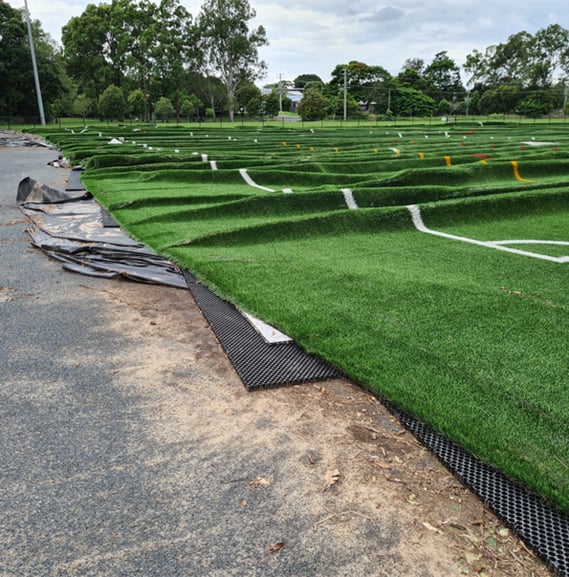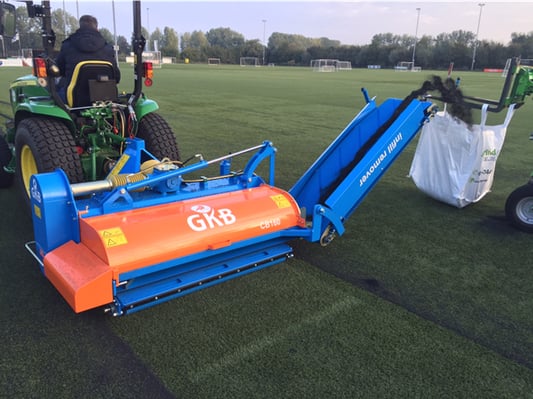With unprecedented rain events over the past 6 months, in New South Wales and Queensland, synthetic grass fields and courts have been affected to varying degrees. In the worst cases, fields have been made unplayable, requiring complete re-builds, while other facilities have been left with extensive cleanup projects.
What have we learnt and what can we take away from the results of the effects of recent flood events?
Quite often our sports fields/courts are constructed in low-lying, flood-prone areas (due to these sites not being suitable for property development).
Thus, knowing that at some stage through the life of the facility, it will be subject to flooding, we can design to mitigate or minimize the damage floods will cause.
Flood damages for long pile synthetic grass fields
These surfaces have paid a heavy price in some instances where flood waters and in particular the velocity of the flood waters, have had major impacts on the surface, requiring some fields to be completely removed and a new surface re-laid at considerable costs.
Long pile synthetic grass fields require the sand infill to act as ballast and weight the field down, so there is no movement during use. The rubber or organic performance infill is the top layer of the system.
Flood waters can impact these fields in two main ways:
- Flood waters rising above the perimeter edge of the field and flowing across the field. These waters bring contaminants onto the field, which filter down through the infill and sit within the synthetic grass layer. The contaminants ( ie silts, mud, organic material etc. ) need to be removed once the flood event has passed, which can require all the infill to be removed and replaced.
Some of the infills can be lifted by the water and be carried with the flood waters off the field. Thus additional infill material is required and the field will need to be re- groomed to the correct levels.
In extreme cases, the speed at which flood waters travel across the field, can flow underneath the synthetic grass and lift the entire system, grass and infill, and push/wrinkle the synthetic grass. In these cases, it is very difficult to pull the grass back into position without damaging the grass. The synthetic grass will often have to be removed from the site and new grass and infill installed. - Flood waters backing back up through the external stormwater system and back into the field stormwater system. The stormwater water from the rainfall event is unable to discharge from the field and starts to back up through the synthetic grass and ponds on the surface.
As a result, some of the infills may be carried off the field at the low end and will be replaced and the field re-groomed.


Long pile synthetic turf Field of Play surface being damaged by flood
What are the possible solutions for mitigating flood damages on long pile synthetic grass fields?
- Design fields with upstands around fields, which are above the High Water Level of storm event being considered. The aim is to divert flood waters around the field. Also, having a raised upstand provides a retention volume to keep infill within the field of play.
- Provide grated pits downstream of the field stormwater system, to allow stormwater that is backing up in the system to surcharge before entering back under the field.
- Design of vertically draining pavements, to allow for retention of stormwater within the field.

Slit and infill being removed by mechanical broom
Flood damages for short pile synthetic grass fields/courts
Short pile synthetic grass is generally used for Hockey fields, Tennis Courts and Multi-use courts. These surfaces are generally weight down with sand infill, to hold the surface in place.
Flood waters have similar impacts as with long piles, contaminants are deposited over the surface, as flood waters pass over the top surface and potentially move the grass surface or disturb the underlying base pavement.
The main impact flood waters can impact on these fields/courts is flood waters rising above the perimeter edge of the field and flowing across the field/court. These waters bring contaminants onto the field, which filter down through the infill and sit within the synthetic grass layer. The contaminants (ie silts, mud, organic material etc) can be removed with high-pressure water cleaning. A majority of the sand infill will also be removed during the cleaning process and will need new sand to be installed to the correct levels.
If the synthetic grass surface is not glued around the perimeter, there is the risk of flood waters moving at speed across the surface, can enter under the grass and causing damage to the underlying base pavement (Crushed rock, Asphalt or Concrete).
If the surface is laid on crushed rock, the rock surface can be scoured, leaving the surface with depressions and ridges. The synthetic grass surface will need to be removed and the base regraded and compacted.
With synthetic grass laid on asphalt or concrete, the flood waters can leave silts and mud behind on the asphalt or concrete pavement. Again the synthetic grass will need to be removed, to allow the contaminates to be pressure washed off the surface and then the grass re-laid.
With Hockey Fields / Courts, stormwater is moved horizontally across the surface to an external stormwater drainage system, thus is unlikely to be affected by water backing up in the stormwater system. In general, there is no internal subsurface drainage system within the field or courts, thus no risk of contamination returning through the external system.
 Short pile sand-filled synthetic turf Field of Play surface being damaged by flood
Short pile sand-filled synthetic turf Field of Play surface being damaged by flood
What are the possible solutions for mitigating flood damages on short pile synthetic grass fields/courts?
- Design fields/courts with upstands around the perimeter, which is above the High Water Level of storm event being considered. The aim is to divert flood waters around the field and also provides a retention volume to keep infill within the field of play.
- Provide grated pits downstream of the field stormwater system, to allow stormwater that is backing up in the system to surcharge before entering back under the field.
- Adhere/glue the synthetic grass to concrete perimeter edges, to prevent flood waters from entering beneath the surface.
If you have any further questions about this topic or would like to reach out to discuss more, please contact andrew.morrow@sporteng.com.au
Alternatively, we have put together a library of information to help you get your Fields of Play back into tip-top condition post floods and how to provide more flood-resilient sports fields across all surfaces:
👉 What are the consequences of flooding on sportfield natural turf?
👉 Fields of Play post-flood readiness and remediation works - Webinar
👉 What are the impacts of climate change on Australia's climate?

